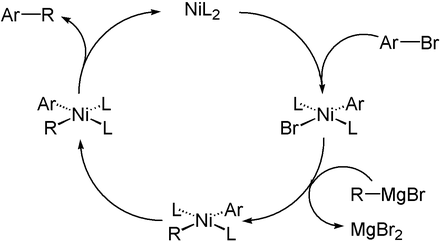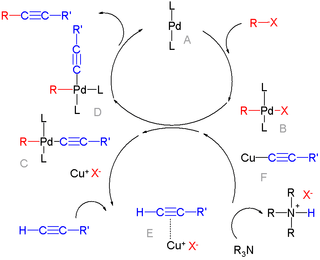Cross-coupling reaction
A cross-coupling reaction in organic chemistry is a reaction where two fragments are joined together with the aid of a metal catalyst. In one important reaction type, a main group organometallic compound of the type R-M (R = organic fragment, M = main group center) reacts with an organic halide of the type R'-X with formation of a new carbon-carbon bond in the product R-R'.[1][2][3] Cross-coupling reaction are a subset of coupling reactions. It is often used in arylations.
Richard F. Heck, Ei-ichi Negishi, and Akira Suzuki were awarded the 2010 Nobel Prize in Chemistry for developing palladium-catalyzed cross coupling reactions.[4][5]
Mechanism

The mechanism generally involves reductive elimination of the organic substituents R and R' on a metal complex of the type LnMR(R') (where L is some arbitrary spectator ligand). The crucial intermediate LnMR(R') is formed in a two step process from a low valence precursor Ln. The oxidative addition of an organic halide (RX) to LnM gives LnMR(X). Subsequently, the second partner undergoes transmetallation with a source of R'−. The final step is reductive elimination of the two coupling fragments to regenerate the catalyst and give the organic product. Unsaturated organic groups couple more easily in part because they add readily. The intermediates are also less prone to beta-hydride elimination.[6]
Catalysts

Catalysts are often based on palladium, which is frequently selected due to high functional group tolerance. Organopalladium compounds are generally stable towards water and air. industry, which faces extensive regulation regarding heavy metals. Many pharmaceutical chemists attempt to use coupling reactions early in production to minimize metal traces in the product.[7] Heterogeneous catalysts based on Pd are also well developed.[8]
Copper-based catalysts are also common, especially for coupling involving heteroatom-C bonds.[9][10]
Iron-,[11] cobalt-,[12] and nickel-based nickel.[13] catalysts have been investigated.
Leaving groups
The leaving group X in the organic partner is usually a halide, although triflate, tosylate and other pseudohalide have been used. Chloride is an ideal group due to the low cost of organochlorine compounds. Frequently, however, C-Cl bonds are too inert, and bromide or, worse, iodide leaving groups are required for acceptable rates. The main group metal in the organometallic partner usually is an electropositive element such as tin, zinc, silicon, or boron.
Carbon-carbon cross-coupling
Many cross-couplings entail forming carbon-carbon bonds.
| Reaction | Year | Reactant A | Reactant B | Catalyst | Remark | ||
|---|---|---|---|---|---|---|---|
| Cadiot-Chodkiewicz coupling | 1957 | RC≡CH | sp | RC≡CX | sp | Cu | requires base |
| Castro-Stephens coupling | 1963 | RC≡CH | sp | Ar-X | sp2 | Cu | |
| Corey-House synthesis | 1967 | R2CuLi or RMgX | sp3 | R-X | sp2, sp3 | Cu | Cu-catalyzed version by Kochi, 1971 |
| Kumada coupling | 1972 | Ar-MgBr | sp2, sp3 | Ar-X | sp2 | Pd or Ni or Fe | |
| Heck reaction | 1972 | alkene | sp2 | Ar-X | sp2 | Pd or Ni | requires base |
| Sonogashira coupling | 1975 | RC≡CH | sp | R-X | sp3 sp2 | Pd and Cu | requires base |
| Negishi coupling | 1977 | R-Zn-X | sp3, sp2, sp | R-X | sp3 sp2 | Pd or Ni | |
| Stille cross coupling | 1978 | R-SnR3 | sp3, sp2, sp | R-X | sp3 sp2 | Pd | |
| Suzuki reaction | 1979 | R-B(OR)2 | sp2 | R-X | sp3 sp2 | Pd or Ni | requires base |
| Murahashi coupling[14] | 1979 | R-Li | sp2, sp3 | R-X | sp2 | Pd or Ru | |
| Hiyama coupling | 1988 | R-SiR3 | sp2 | R-X | sp3 sp2 | Pd | requires base |
| Fukuyama coupling | 1998 | R-Zn-I | sp3 | RCO(SEt) | sp2 | Pd or Ni | see Liebeskind–Srogl coupling, gives ketones |
| Liebeskind–Srogl coupling | 2000 | R-B(OR)2 | sp3, sp2 | RCO(SEt) Ar-SMe | sp2 | Pd | requires CuTC, gives ketones |
Carbon-heteroatom coupling
Many cross-couplings entail forming carbon-heteroatom bonds (heteroatom = S, N, O). A popular method is the Buchwald–Hartwig reaction:
-
 The Buchwald–Hartwig reaction
The Buchwald–Hartwig reaction(Eq.1)
| Reaction | Year | Reactant A | Reactant B | Catalyst | Remark | ||
|---|---|---|---|---|---|---|---|
| Ullmann-type reaction | ArO-MM, ArNH2,RS-M,NC-M | sp3 | Ar-X (X = OAr, N(H)Ar, SR, CN) | sp2 | Cu | ||
| Chan-Lam coupling[15] | Ar-B(OR)2 | sp2 | Ar-NH2 | sp2 | Cu | ||
| Buchwald-Hartwig reaction[16] | 1994 | R2N-H | sp3 | R-X | sp2 | Pd | N-C coupling, second generation free amine |
Miscellaneous reactions
One method for palladium-catalyzed cross-coupling reactions of aryl halides with fluorinated arenes was reported by Keith Fagnou and co-workers. It is unusual in that it involves C-H functionalisation at an electron deficient arene.[17]

Applications
Cross-coupling reactions are important for the production of pharmaceuticals,[3] examples being montelukast, eletriptan, naproxen, varenicline, and resveratrol.[18] Some polymers and monomers are also prepared in this way.[6]
Reviews
- Fortman, George C.; Nolan, Steven P. (2011). "N-Heterocyclic carbene (NHC) ligands and palladium in homogeneous cross-coupling catalysis: a perfect union". Chemical Society Reviews. 40 (10): 5151–69. doi:10.1039/c1cs15088j. PMID 21731956.
- Yin; Liebscher, Jürgen (2007). "Carbon−Carbon Coupling Reactions Catalyzed by Heterogeneous Palladium Catalysts". Chemical Reviews. 107 (1): 133–173. doi:10.1021/cr0505674. PMID 17212474. S2CID 36974481.
- Jana, Ranjan; Pathak, Tejas P.; Sigman, Matthew S. (2011). "Advances in Transition Metal (Pd,Ni,Fe)-Catalyzed Cross-Coupling Reactions Using Alkyl-organometallics as Reaction Partners". Chemical Reviews. 111 (3): 1417–1492. doi:10.1021/cr100327p. PMC 3075866. PMID 21319862.
- Molnár, Árpád (2011). "Efficient, Selective, and Recyclable Palladium Catalysts in Carbon−Carbon Coupling Reactions". Chemical Reviews. 111 (3): 2251–2320. doi:10.1021/cr100355b. PMID 21391571.
- Miyaura, Norio.; Suzuki, Akira. (1995). "Palladium-Catalyzed Cross-Coupling Reactions of Organoboron Compounds". Chemical Reviews. 95 (7): 2457–2483. CiteSeerX 10.1.1.735.7660. doi:10.1021/cr00039a007.
- Roglans, Anna; Pla-Quintana, Anna; Moreno-Mañas, Marcial (2006). "Diazonium Salts as Substrates in Palladium-Catalyzed Cross-Coupling Reactions". Chemical Reviews. 106 (11): 4622–4643. doi:10.1021/cr0509861. PMID 17091930. S2CID 8128630.
References
- Organic Synthesis using Transition Metals Rod Bates ISBN 978-1-84127-107-1
- New Trends in Cross-Coupling: Theory and Applications Thomas Colacot (Editor) 2014 ISBN 978-1-84973-896-5
- King, A. O.; Yasuda, N. (2004). "Palladium-Catalyzed Cross-Coupling Reactions in the Synthesis of Pharmaceuticals". Organometallics in Process Chemistry. Topics in Organometallic Chemistry. 6. Heidelberg: Springer. pp. 205–245. doi:10.1007/b94551. ISBN 978-3-540-01603-8.CS1 maint: multiple names: authors list (link)
- "The Nobel Prize in Chemistry 2010 - Richard F. Heck, Ei-ichi Negishi, Akira Suzuki". NobelPrize.org. 2010-10-06. Retrieved 2010-10-06.
- Johansson Seechurn, Carin C. C.; Kitching, Matthew O.; Colacot, Thomas J.; Snieckus, Victor (2012). "Palladium-Catalyzed Cross-Coupling: A Historical Contextual Perspective to the 2010 Nobel Prize". Angewandte Chemie International Edition. 51 (21): 5062–5085. doi:10.1002/anie.201107017. PMID 22573393. S2CID 20582425.
- Hartwig, J. F. Organotransition Metal Chemistry, from Bonding to Catalysis; University Science Books: New York, 2010. ISBN 1-891389-53-X
- Thayer, Ann (2005-09-05). "Removing Impurities". Chemical & Engineering News. Retrieved 2015-12-11.
- Yin; Liebscher, J. (2007). "Carbon−Carbon Coupling Reactions Catalyzed by Heterogeneous Palladium Catalysts". Chemical Reviews. 107 (1): 133–173. doi:10.1021/cr0505674. PMID 17212474. S2CID 36974481.CS1 maint: multiple names: authors list (link)
- Corbet, Jean-Pierre; Mignani, Gérard (2006). "Selected Patented Cross-Coupling Reaction Technologies". Chemical Reviews. 106 (7): 2651–2710. doi:10.1021/cr0505268. PMID 16836296.
- Evano, Gwilherm; Blanchard, Nicolas; Toumi, Mathieu (2008). "Copper-Mediated Coupling Reactions and Their Applications in Natural Products and Designed Biomolecules Synthesis". Chemical Reviews. 108 (8): 3054–3131. doi:10.1021/cr8002505. PMID 18698737.
- Robin B. Bedford (2015). "How Low Does Iron Go? Chasing the Active Species in Fe-Catalyzed Cross-Coupling Reactions". Acc. Chem. Res. 48 (5): 1485–1493. doi:10.1021/acs.accounts.5b00042. PMID 25916260.
- Cahiez, GéRard; Moyeux, Alban (2010). "Cobalt-Catalyzed Cross-Coupling Reactions". Chemical Reviews. 110 (3): 1435–1462. doi:10.1021/cr9000786. PMID 20148539.
- Rosen, Brad M.; Quasdorf, Kyle W.; Wilson, Daniella A.; Zhang, Na; Resmerita, Ana-Maria; Garg, Neil K.; Percec, Virgil (2011). "Nickel-Catalyzed Cross-Couplings Involving Carbon−Oxygen Bonds". Chemical Reviews. 111 (3): 1346–1416. doi:10.1021/cr100259t. PMC 3055945. PMID 21133429.
- Murahashi, Shunichi; Yamamura, Masaaki; Yanagisawa, Kenichi; Mita, Nobuaki; Kondo, Kaoru (1979). "Stereoselective synthesis of alkenes and alkenyl sulfides from alkenyl halides using palladium and ruthenium catalysts". The Journal of Organic Chemistry. 44 (14): 2408–2417. doi:10.1021/jo01328a016. ISSN 0022-3263.
- Jennifer X. Qiao, Patrick Y.S. Lam (2011). "Recent Advances in Chan–Lam Coupling Reaction: Copper-Promoted C–Heteroatom Bond Cross-Coupling Reactions with Boronic Acids and Derivatives". In Dennis G. Hall (ed.). Boronic Acids: Preparation and Applications in Organic Synthesis, Medicine and Materials. Wiley-VCH. pp. 315–361. doi:10.1002/9783527639328.ch6. ISBN 9783527639328.
- Ruiz-Castillo, P.; Buchwald, S. L. (2016). "Applications of Palladium-Catalyzed C–N Cross-Coupling Reactions". Chemical Reviews. 116 (19): 12564–12649. doi:10.1021/acs.chemrev.6b00512. PMC 5070552. PMID 27689804.CS1 maint: multiple names: authors list (link)
- M. Lafrance; C. N. Rowley; T. K. Woo; K. Fagnou (2006). "Catalytic Intermolecular Direct Arylation of Perfluorobenzenes". J. Am. Chem. Soc. 128 (27): 8754–8756. CiteSeerX 10.1.1.631.607. doi:10.1021/ja062509l. PMID 16819868.
- Cornils, Boy; Börner, Armin; Franke, Robert; Zhang, Baoxin; Wiebus, Ernst; Schmid, Klaus (2017). "Hydroformylation". Applied Homogeneous Catalysis with Organometallic Compounds. pp. 23–90. doi:10.1002/9783527651733.ch2. ISBN 9783527328970.